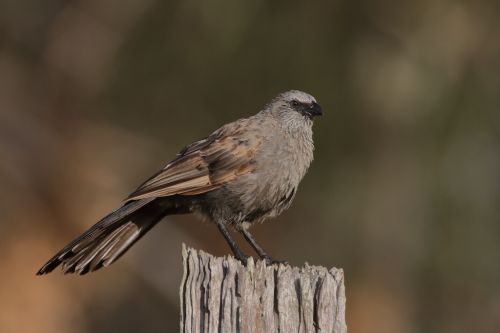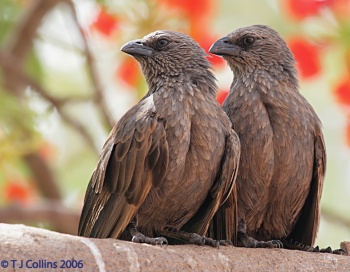(Clearer image. Imp sizes.) |
(→External Links: New VSearch created) |
||
| (11 intermediate revisions by 3 users not shown) | |||
| Line 1: | Line 1: | ||
| − | [[Image:Apostlebird4.JPG|thumb| | + | [[Image:Apostlebird4.JPG|thumb|500px|right|Photo © by {{user|Ken+Doy|Ken Doy}}<br />Taromeo, [[Queensland]], January 2017]] |
;[[: Category:Struthidea|Struthidea]] cinerea | ;[[: Category:Struthidea|Struthidea]] cinerea | ||
==Identification== | ==Identification== | ||
| − | [[Image:Apostlebird_by_stoop.jpg|thumb|350px|right|Photo by {{user|stoop|stoop}}<br />Darling Downs, [[Queensland]], [[Australia]], June 2007]] | + | [[Image:Apostlebird_by_stoop.jpg|thumb|350px|right|Photo © by {{user|stoop|stoop}}<br />Darling Downs, [[Queensland]], [[Australia]], June 2007]] |
| − | Length 29-33 cm (11½-13). <br /> | + | Length 29-33 cm (11½-13 in). <br /> |
Mostly grey with soft-looking body feathers. Flight feathers are brown, tail is black, legs are dark, the short, strong bill is black. However, the Birdforum Gallery (link below) show several images of birds with a much more reddish-brown color, be that due to true variation, staining, or an effect of unusual light conditions (see lower image). | Mostly grey with soft-looking body feathers. Flight feathers are brown, tail is black, legs are dark, the short, strong bill is black. However, the Birdforum Gallery (link below) show several images of birds with a much more reddish-brown color, be that due to true variation, staining, or an effect of unusual light conditions (see lower image). | ||
==Distribution== | ==Distribution== | ||
| Line 10: | Line 10: | ||
The only close relative of the Apostlebird is the [[White-winged Chough]]. | The only close relative of the Apostlebird is the [[White-winged Chough]]. | ||
====Subspecies==== | ====Subspecies==== | ||
| − | [[Image:Apostlebird.jpg|thumb|350px|right|Colors seem atypical<br />Photo by {{user|tcollins|tcollins}} <br />Daly waters, [[Northern Territory]], [[Australia]], December 2006]] | + | [[Image:Apostlebird.jpg|thumb|350px|right|Colors seem atypical<br />Photo © by {{user|tcollins|tcollins}} <br />Daly waters, [[Northern Territory]], [[Australia]], December 2006]] |
Two subspecies are recognized<sup>[[#References|[1]]]</sup>: | Two subspecies are recognized<sup>[[#References|[1]]]</sup>: | ||
*''S. c. dalyi'': | *''S. c. dalyi'': | ||
| Line 23: | Line 23: | ||
The diet includes insects and seeds. | The diet includes insects and seeds. | ||
====Flight==== | ====Flight==== | ||
| + | [[Image:Apostlebird-A5322W.jpg|thumb|350px|right|Photo © by '''[http://www.birdforum.net/member.php?u=49168 Hans&Judy Beste]'''<br />Taromeo, S.E. [[Queensland]], September 2018]] | ||
Their flight has a characteristic pattern of flapping intermingled with gliding. | Their flight has a characteristic pattern of flapping intermingled with gliding. | ||
====Breeding==== | ====Breeding==== | ||
This species are communal mudnest builders, who, as suggested by the name, work in large groups building their mudnests on a tree branch and feeding their young ones. Not always making up a dozen birds, but with several generations helping in the rearing of their young. This group behavior apparantly lead to the name used for this species<sup>[[#References|[2]]]</sup>. | This species are communal mudnest builders, who, as suggested by the name, work in large groups building their mudnests on a tree branch and feeding their young ones. Not always making up a dozen birds, but with several generations helping in the rearing of their young. This group behavior apparantly lead to the name used for this species<sup>[[#References|[2]]]</sup>. | ||
====Vocalisation==== | ====Vocalisation==== | ||
| − | + | {{Audio|Apostlebird.mp3}} | |
| − | + | ||
| − | Feeding chatter<br />Recorded by {{user|Azzy|Azzy}} at Danggali Conservation Park, [[South Australia]]. 11th May 2009. | + | Feeding chatter |
| + | <br />Recorded by {{user|Azzy|Azzy}} at Danggali Conservation Park, [[South Australia]]. 11th May 2009. | ||
==References== | ==References== | ||
| − | #{{Ref- | + | #{{Ref-Clements6thAug18}}#Encyclopaedia Britannica |
#BF Member observations | #BF Member observations | ||
| + | *[http://www.arthurgrosset.com/ozbirds/apostlebird.html Arthur Grosset's Birds] | ||
{{ref}} | {{ref}} | ||
==External Links== | ==External Links== | ||
| − | + | {{GSearch|"Struthidea cinerea" {{!}} "Apostlebird"}} | |
| − | {{ | + | <br /> |
| + | {{VSearch|"Struthidea cinerea" {{!}} "Apostlebird"}} | ||
| + | {{GS-checked}}1 | ||
| + | <br /> | ||
| + | <br /> | ||
| − | [[Category:Birds]][[Category:Struthidea]][[Category:Bird Songs]] | + | [[Category:Birds]][[Category:Struthidea]][[Category:Bird Songs]] [[Category:Videos]] |
Latest revision as of 20:13, 30 April 2023
- Struthidea cinerea
Identification
Length 29-33 cm (11½-13 in).
Mostly grey with soft-looking body feathers. Flight feathers are brown, tail is black, legs are dark, the short, strong bill is black. However, the Birdforum Gallery (link below) show several images of birds with a much more reddish-brown color, be that due to true variation, staining, or an effect of unusual light conditions (see lower image).
Distribution
North, east, and south Australia. Highly nomadic.
Taxonomy
The only close relative of the Apostlebird is the White-winged Chough.
Subspecies
Two subspecies are recognized[1]:
- S. c. dalyi:
- Interior of Northern Territory and northern Queensland
- S. c. cinerea:
- Central Queensland to northern Victoria and south-eastern South Australia
Habitat
Woodlands near water, farmlands with trees, roadsides, orchards and golf courses. Open scrub and eucalypt forests
Behaviour
Diet
The diet includes insects and seeds.
Flight
Their flight has a characteristic pattern of flapping intermingled with gliding.
Breeding
This species are communal mudnest builders, who, as suggested by the name, work in large groups building their mudnests on a tree branch and feeding their young ones. Not always making up a dozen birds, but with several generations helping in the rearing of their young. This group behavior apparantly lead to the name used for this species[2].
Vocalisation
Feeding chatter
Recorded by Azzy at Danggali Conservation Park, South Australia. 11th May 2009.
References
- Clements, J. F., T. S. Schulenberg, M. J. Iliff, D. Roberson, T. A. Fredericks, B. L. Sullivan, and C. L. Wood. 2018. The eBird/Clements checklist of birds of the world: v2018. Downloaded from http://www.birds.cornell.edu/clementschecklist/download/
- Encyclopaedia Britannica
- BF Member observations
Recommended Citation
- BirdForum Opus contributors. (2024) Apostlebird. In: BirdForum, the forum for wild birds and birding. Retrieved 3 May 2024 from https://www.birdforum.net/opus/Apostlebird
External Links
GSearch checked for 2020 platform.1







